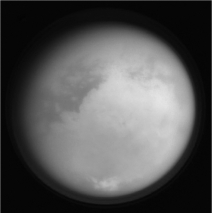Titan's thick atmosphere (see the image below) is hypothesized to have been created when ultraviolet photons broke apart methane molecules,ultimately creating the observed smog-like conditions.This process,though,would likely remove all of the atmospheric methane in roughly 10 million years,yet we still see its presence today.How can this be? 
A) Cometary impacts periodically bring new methane to Titan.
B) Ethane rains down out of the atmosphere, combines with surface rocks, and creates new methane.
C) Infrared photons give atmospheric molecules enough energy to recombine into methane.
D) Volcanoes on Titan periodically release new methane into the atmosphere.
Correct Answer:
Verified
Q10: Which of following is FALSE?
A) Pluto has
Q12: Which of the following can be used
Q13: Eris and Ceres are examples of
A) asteroids.
B)
Q14: Which property of a moon might lead
Q17: How do particles from Enceladus wind up
Q19: Which moon gives rise to the particles
Q28: Most asteroids are closest in shape to
A)
Q29: The mass of all the known asteroids
Q32: Which of the following is NOT geologically
Q39: Which of the following moons is thought
Unlock this Answer For Free Now!
View this answer and more for free by performing one of the following actions

Scan the QR code to install the App and get 2 free unlocks

Unlock quizzes for free by uploading documents